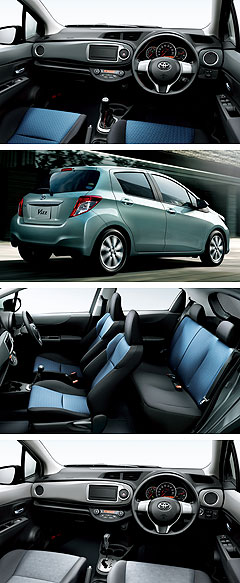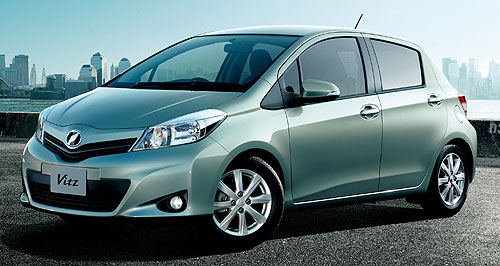Make / Model Search
Future models - Toyota - YarisToyota Oz delays next YarisBehind schedule: The new Toyota Yaris will make its Australian public debut at AIMS in July before going on sale here in the last quarter of this year. Next-generation Toyota Yaris will be up to two months late due to Japan quake7 Jun 2011 TOYOTA Australia has confirmed the release of its vital new Yaris hatchback will be delayed by up to two months as a direct result of Japan’s crippling March earthquake and tsunami. First revealed last October, the bigger and more efficient new third-generation Yaris was launched in three- and five-door hatch guises in Japan last December and both body derivatives were due for Australian release in September. However, in a press release heralding the redesigned model’s local debut at the Australian International Motor Show (AIMS) in Melbourne on July 1, Toyota this week said the MkIII Yaris would go on sale here in the final quarter of this year. Toyota Australia public relations manager Mike Breen told GoAuto the local Yaris launch had been delayed by “about a month to two months”, making a November release date most likely. However, he denied further delays at Toyota’s quake-ravaged Nagakusa factory in Japan could prevent the company’s smallest Australian model going on sale here this year. “The (current) plan is to have it out this year,” said Mr Breen.  “September was the pre-tsunami target. It (the Toyota factory in which the Yaris is produced in Japan) was badly affected by the tsunami and the earthquake, so Yaris production has been severely limited over the last few months.” The new Yaris sedan, which is yet to appear, will follow the two new Yaris hatch models into showrooms some time next year, until which time the existing model will continue on sale alongside the new hatchbacks. However, Toyota’s Australian dealers remain short of all Yaris models and despite the hatch being in run-out sales plummeted by almost 60 per cent last month. Before it was outsold by Hyundai’s Getz in 2009 and – by just 95 vehicles – 2010, the Yaris has long been Australia’s top-selling light car. So far this year, however, Yaris sales are down more than 29 per cent and its share of Australia’s smallest vehicle segment has shrunk from 16.7 to just 12 per cent. Meanwhile, the Getz holds 15.7 per cent, the Mazda2 has also outsold the Yaris with 12.6 per cent and Ford’s Fiesta lies less than 1000 cars adrift with a 10.3 per cent share. Japan’s total vehicle production slumped by 60.1 per cent in April, when Toyota produced just 53,823 vehicles – a 78.4 per cent plunge from the same month last year. Power shortages continue to affect most Japanese manufacturers, but Toyota’s domestic operations were due to return to 90 per cent of capacity by this month and Toyota expects domestic production to return to full capacity by the end of this year. Australian operations resumed normal production this week. Toyota will show a pre-production Yaris five-door at AIMS and has confirmed the new model will continue to be produced for Australia in Japan, rather than Thailand. The Japanese giant revealed a hybrid-powered Yaris concept at the Geneva motor show in March, but has ruled out a petrol-electric version of the new Yaris for Australia in its current generation. Instead, Toyota Australia is considering the local release of the Prius C and/or Prius V people-movers, which will also make their Australian debuts in Melbourne, alongside the FT-86 II sports coupe concept and Toyota’s facelifted HiLux ute. The current Yaris hatch was released in Australia in November 2005 as a replacement for the Echo – sold as the first-generation Yaris overseas and Australia’s most popular light car between 2003 and 2005 – before the sedan joined it in March 2006. A combined total of more 200,000 Echo and Yaris sales in Australia have contributed to total global sales of more than 3.5 million. As we reported last year, the MkIII Yaris hatch is a full 135mm longer than the current model (3885 versus 3750mm), with a 50mm-longer wheelbase liberating 35mm of extra cabin length (now 1915mm) cabin and 35mm more rear legroom. Despite that, Toyota says the edgier new Yaris – which is the same width as before (1695mm) but about 20mm lower at 1500mm – offers a slightly tighter turning circle of 9.0 metres, improved aerodynamic efficiency of 0.285Cd (down from 0.30) and is about 30kg lighter at 1000kg in base trim. Inside, Toyota says all models come with new front seat frames to improve comfort, a 60/40-split folding rear seat, 60mm of driver’s seat height adjustment (up 15mm), 10mm of extra front seat slide adjustment, a 145mm-deeper cargo floor with a new two-height deck board, a plastic barrier to confine cargo on the front passenger seat and automatic headlights. New Yaris features include a single windscreen wiper with integrated washer nozzle, and ultraviolet-reducing front-door glass, which Toyota says is the first in the world to reduce 99 per cent of UV light – the same level of UV protection as wearing gloves. All Japanese-spec models will come with twin front airbags (with the option of front-side and curtain airbags), electronic traction/stability control, ABS brakes and electronic brake-force distribution (EBD), while customers can pay extra for a hard-drive navigation system steering wheel controls and a colour rear-view monitor for reverse parking. In Japan, where an entry-level 1.0-litre version is also available, all Yaris 1.3s will be powered by Toyota’s 1NR-FE engine with dual variable valve timing (instead of the current model’s VVT-i system), matched with either a five-speed manual gearbox or a continuously variable, dubbed Super CVT-i. The fitment of an idle-stop system in a 1.3-litre four-cylinder petrol model with front-wheel drive in Japan (where all-wheel models are also available) will reduce fuel consumption to a headline-grabbing 4.6L/100km and CO2 emissions to 106g/km, according to that nation’s latest JC08 test cycle. Australia’s new Yaris line-up is yet to be confirmed, but Toyota says that makes the new Yaris the most fuel-efficient new vehicle in Japan, where the Yaris is known as the ‘Vitz’, excluding mini (Kei) cars and hybrid models like the Prius. In other overseas markets the new Yaris is also available with a 1.0-litre petrol engine and a 1.4-litre diesel, but Toyota is yet to release any diesel models in Australia except for the LandCruiser and HiLux. Yaris pricing, which was reduced to $14,990 plus on-road costs for the entry-level 1.3-litre YR three-door hatch last October, is unlikely to be revealed until the new model’s late-2011 launch. The new Yaris will face stiff competition from other new light-car contenders due around the same time, including Hyundai’s new Accent sedan and Holden’s redesigned Barina range, as well as a sedan version of Nissan’s new Micra and Mitsubishi’s all-new Colt in 2012.  Read more2nd of June 2011  Quake cripples Japan production in AprilJapan auto production down 60 per cent in April, Toyota makes 78 per cent fewer cars8th of February 2011  Geneva show: Toyota Yaris goes hybridBaby Toyota to get the Prius treatment as hybrid technology extends across the range10th of January 2011  New Toyota Yaris set to come from JapanToyota sticks with Japanese sourcing for 2011 Yaris – at least for starters23rd of December 2010  First look: Toyota yields new YarisNext Yaris launched in Japan but Aussies must wait longer for new Toyota babyAll future models Alfa Romeo Alfa Romeo Abarth Abarth Alpine Alpine Alpina Alpina Audi Audi Aston Martin Aston Martin BMW BMW Bentley Bentley Chery Chery Brabham Brabham Chrysler Chrysler Chevrolet Chevrolet Cupra Cupra Citroen Citroen DS DS Dodge Dodge Fiat Fiat Ferrari Ferrari Foton Foton Ford Ford Great Wall Great Wall FPV FPV Haval Haval GWM GWM Honda Honda Holden Holden Hummer Hummer HSV HSV Infiniti Infiniti Hyundai Hyundai Jaguar Jaguar Isuzu Isuzu Kia Kia Jeep Jeep Land Rover Land Rover Lamborghini Lamborghini Lexus Lexus LDV LDV Mahindra Mahindra Lotus Lotus Mazda Mazda Maserati Maserati Mercedes-AMG Mercedes-AMG McLaren McLaren MG MG Mercedes-Benz Mercedes-Benz Mitsubishi Mitsubishi Mini Mini Opel Opel Nissan Nissan Peugeot Peugeot Pagani Pagani Proton Proton Porsche Porsche Renault Renault Ram Ram Rover Rover Rolls-Royce Rolls-Royce Skoda Skoda Saab Saab SsangYong SsangYong Smart Smart Suzuki Suzuki Subaru Subaru Toyota Toyota Tesla Tesla Volvo VolvoYaris pricingMotor industry news |
Click to shareToyota modelsResearch Toyota All future models Alfa Romeo Alfa Romeo Abarth Abarth Alpine Alpine Alpina Alpina Audi Audi Aston Martin Aston Martin BMW BMW Bentley Bentley Chery Chery Brabham Brabham Chrysler Chrysler Chevrolet Chevrolet Cupra Cupra Citroen Citroen DS DS Dodge Dodge Fiat Fiat Ferrari Ferrari Foton Foton Ford Ford Great Wall Great Wall FPV FPV Haval Haval GWM GWM Honda Honda Holden Holden Hummer Hummer HSV HSV Infiniti Infiniti Hyundai Hyundai Jaguar Jaguar Isuzu Isuzu Kia Kia Jeep Jeep Land Rover Land Rover Lamborghini Lamborghini Lexus Lexus LDV LDV Mahindra Mahindra Lotus Lotus Mazda Mazda Maserati Maserati Mercedes-AMG Mercedes-AMG McLaren McLaren MG MG Mercedes-Benz Mercedes-Benz Mitsubishi Mitsubishi Mini Mini Opel Opel Nissan Nissan Peugeot Peugeot Pagani Pagani Proton Proton Porsche Porsche Renault Renault Ram Ram Rover Rover Rolls-Royce Rolls-Royce Skoda Skoda Saab Saab SsangYong SsangYong Smart Smart Suzuki Suzuki Subaru Subaru Toyota Toyota Tesla Tesla Volvo VolvoYaris pricingMotor industry news |











Facebook Twitter Instagram